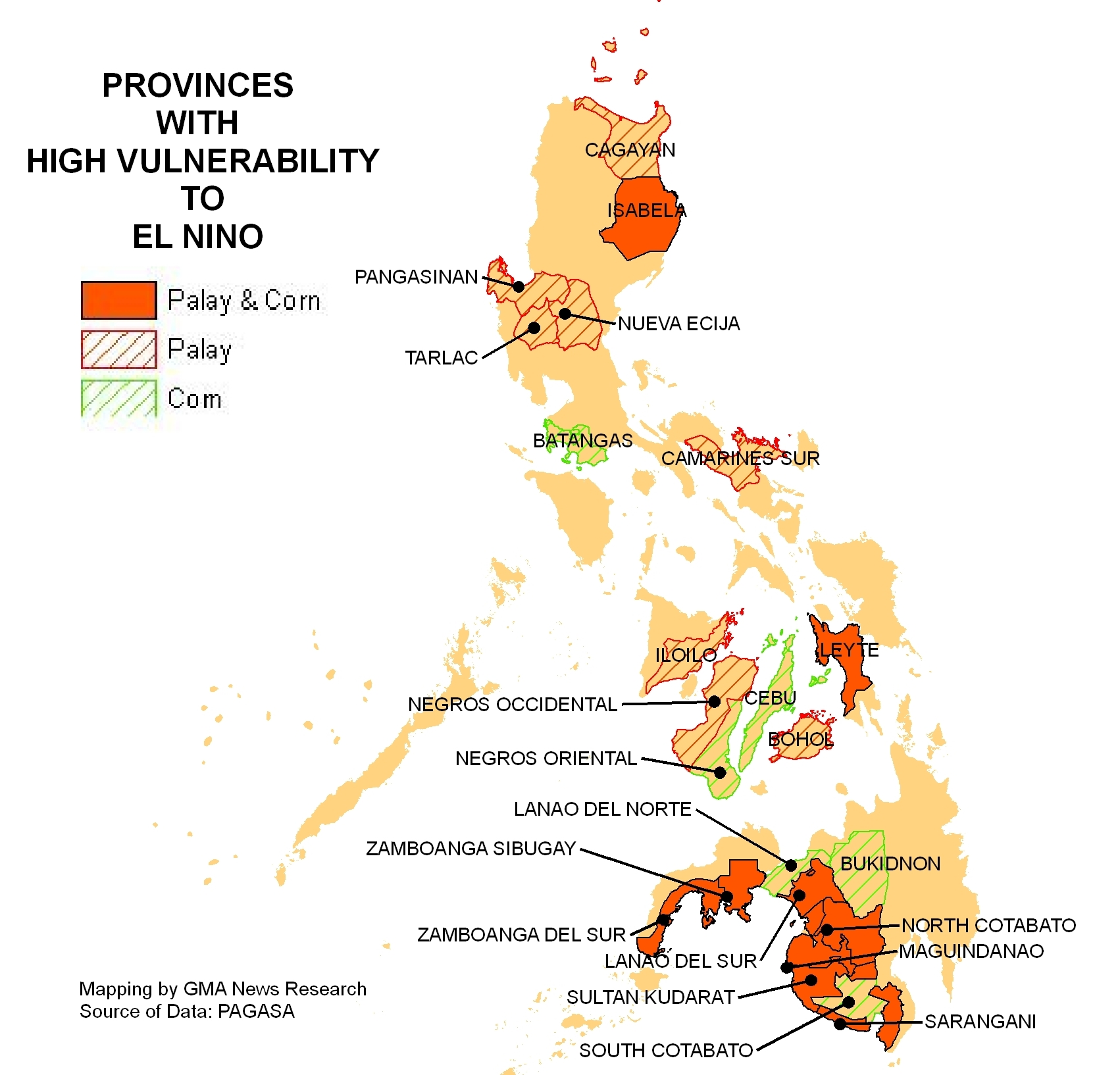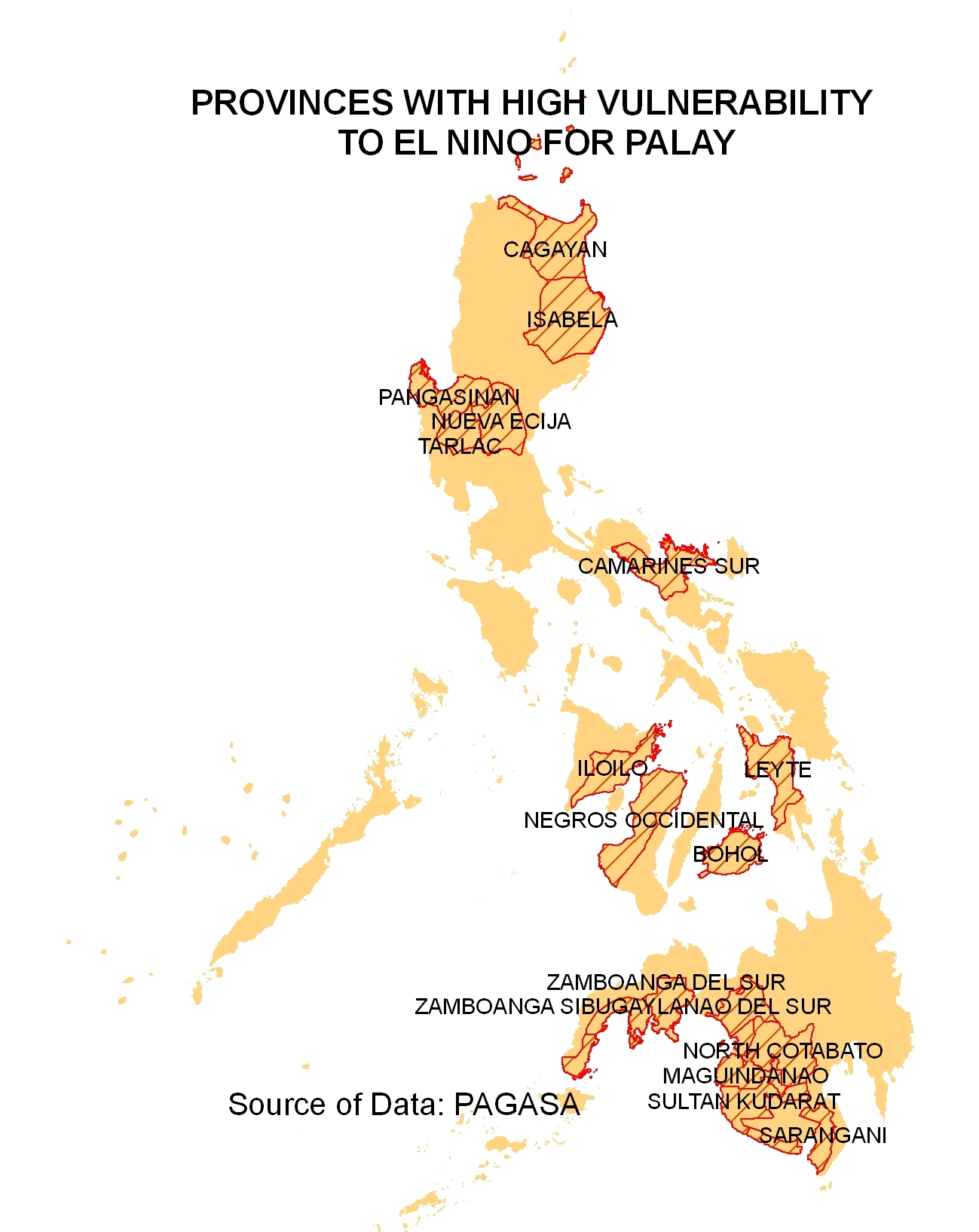Half of PHL’s rice, corn production at risk due to El Niño
A total of 23 provinces that produce half of the country's local supply of rice and corn are at risk of being significantly affected by El Niño.
These provinces include the top producers of the two principal subsistence crops in 2014. Some of these areas were recently placed under a state of calamity.
A PAGASA study (2009) identified the provinces with the highest vulnerability to El Niño—17 provinces for palay and 15 provinces for corn. Among these provinces, nine have high El Niño vulnerability for both crops—Isabela, Lanao del Sur, Leyte, Maguindanao, North Cotabato, Sarangani, Sultan Kudarat, Zamboanga del Sur and Zamboanga Sibugay. (refer to map)
GMA News Research analyzed data from the Department of Agriculture and found out that more than half of the country's total local palay and corn production come from these provinces.
The 17 provinces with the highest vulnerability to El Nino produced a total of 10,608,782 metric tons of palay in 2014 or 56 percent of total local production that year.
GMA News Research calculated that all 17 at-risk provinces produced a total of P190 million of palay in 2014 based on data from DA and the Philippine Statistics Authority.
But an official of the Department of Agriculture said the agency estimated that only around 0.72% of the El Niño-vulnerable rice-producing provinces are affected so far.
Christopher Morales, OIC director of DA's Field Operations Service, placed at P1 billion the estimated damage to palay production so far.
Asked if the current El Niño will affect the overall rice supply, Morales said, "That will depend on the buffer stocks with NFA." A team, which includes a DA representative, assesses whether the supply of rice is enough, he said.
The 15 provinces identified by Pagasa as highly vulnerable to El Niño for corn produced a total of 4,619,003 metric tons or 59% of the total locally produced corn in 2014.
GMA News Research calculation, based on DA and PSA data, show that about P58 to P66 billion worth of yellow or white corn from the 15 at-risk corn-producing provinces.
DA's Morales said the recent El Niño in 2009-2010 damaged a total of P17.4 billion in the agriculture sector. Some P3 billion in crops was damaged during the weak El Niño in 2006-2007, he said. "So kung ikukumpara mo sa ngayon, almost 50 percent pa lang (yung damage)," Morales said.
The PAGASA study assessed the provinces' vulnerability to El Niño using such parameters as available moisture and the size of the area of a province devoted to rice and corn. The study covered the following El Niño years: 1965-66, 1968-69, 1972-73, 1976-77, 1982-83, 1990-94 and 1997-98.
Of the 23 provinces with highest vulnerability, nine are feeling the effects of El Niño so far, based on DA’s monthly agricultural report from January to April 2015. These are Nueva Ecija, Tarlac, Batangas, North Cotabato, Zamboanga Sibugay, Sultan Kudarat, Negros Oriental, Bukidnon and South Cotabato. (see map)
The local government units of the following recently placed their areas under a state of calamity because of the effects of El Niño: M'lang, Kabacan, Makilala, Magpet, Midsayap, Pikit and Kidapawan City in North Cotabato; Koronadal City, T'boli and Surallah in South Cotabato; 19 of 37 barangays in Cotabato City; Zamboanga City; and the entire provinces of Davao del Sur and Maguindanao.
North Cotabato contributes 2.79% of palay and 5.34% of corn in the country. In the town of Alamada alone, about P113 million worth of corn and P13 million worth of palay are damaged so far.
“Nagtanim ang mga farmers (noong) February sa pag-asa na uulanin pa pero hindi nila akalain na matutuyot ang tanim,” said Ed Guleng, municipal agriculture officer of Alamada.
“Kahit mag-cloud seeding wala namang epekto kasi tuyot talaga yung mga mais,” he added.
Guleng said the Bureau of Soils and Water Management said cloud seeding is viable, but the crops were extremely dried up.
“Binebenta na lang yung mga mais bilang feeds sa livestock para naman may kaunting kita ang mga nagtanim,” Guleng says.
In Kidapawan City, North Cotabato, about 24 hectares of rainfed palay, 6.7 hectares of irrigated palay and 14 hectares of white corn were damaged by the ongoing mild El Niño.
In Zamboanga Sibugay, extreme heat and less supply of water caused decreased palay yield.
Among the affected palay areas are Tungawan, RT Lim and Ipil.
In Sultan Kudarat, about 400 hectares of irrigated palay had an insufficient water supply. About 150 hectares of corn areas were affected.
Farmers in San Antonio in Nueva Ecija reported inadequate water supply to use in the fields.
In La Paz, Tarlac, farmers complain of insufficient water supply from their shallow tube wells for irrigating their palay areas.
Morales said the DA had formed an El Niño Task Force which included the National Irrigation Authority. The task force told the different LGUs to do synchronous planting to balance efficiency and loss.
He said the task force also encouraged the use of small-scale shallow tube wells, which can be seen in Cagayan Valley, CALABARZON and MIMAROPA.
"We are also doing an information campaign to save water. We encourage farmers to plant drought-resistant palay seeds and corn needs. We have conducted preliminary checks (through the Bureau of Soils and Water Management) kung saan kailangan,” Morales said. -NB, GMA News




